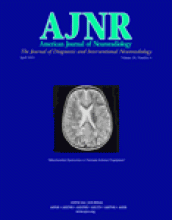Research ArticleBrain
Hemodynamic and Permeability Changes in Posterior Reversible Encephalopathy Syndrome Measured by Dynamic Susceptibility Perfusion-Weighted MR Imaging
Lauren M. Brubaker, J. Keith Smith, Yueh Z. Lee, Weili Lin and Mauricio Castillo
American Journal of Neuroradiology April 2005, 26 (4) 825-830;
Lauren M. Brubaker
J. Keith Smith
Yueh Z. Lee
Weili Lin

References
- ↵Kastrup O, Maschke M, Wanke I, Diener H. Posterior reversible encephalopathy syndrome due to severe hypercalcemia. J Neurol 2002;249:1563–1566
- ↵Sundgren P, Edvardson B, Holtas S. Serial investigarion of perfusion disturbances and vasogenic oedema in hypertensive encephalopathy by diffusion and perfusion weighted imaging. Neuroradiology 2002;44:299–304
- Arora A, Chowdhury D, Daga M, et al. Reversible posterior leukoencephalopathy syndrome: a report of 2 cases. Neurol India 2001;49:311–313
- Eichler F, Wang P, Wityk R, et al. Diffuse metabolic abnormalities in reversible posterior leukoencephalopathy syndrome. AJNR Am J Neuroradiol 2002;23:833–837
- ↵Taylor M, Jackson A, Weller J. Dynamic susceptibility contrast enhanced MRI in reversible posterior leukoencephalopathy syndrome associated with haemolytic uraemic syndrome. Br J Radiol 2000;73:438–442
- ↵Hinchley J, Chaves C, Appignani B, et al. A reversible posterior leukoencephalopathy syndrome. N Engl J Med 1996;334:494–500
- ↵Provenzale JM, Petrella JR, Cruz LC Jr, et al. Quantitative assessment of diffusion abnormalities in posterior reversible encephalopathy syndrome. AJNR Am J Neuroradiol 2000;22:1455–1461
- ↵Engelter ST, Petrella JR, Alberts MJ, Provenzale JM. Assessment of cerebral microcirculation in a patient with hypertensive encephalopathy using MR perfusion imaging. AJR Am J Roentgenol 1999;173:1491–1493
- ↵Weisskoff RM, Boxerman JL, Sorenson AG, et al. Simultaneous blood volume and permeability mapping using a single Gd-based contrast injection [Abstract]. In: Proceedings of the Society of Magnetic Resonance second meeting. San Francisco: Society of Magnetic Resonance;1994 :1:279
- ↵Casey SO, Sampaio RC, Michel E, Truwit CL. Posterior reversible encephalopathy syndrome: utility of fluid-attenuated inversion recovery MR imaging in the detection of cortical and subcortical lesions. AJNR Am J Neuroradiol 2000;21:1199–1206
- ↵Yu E, Roberts TPL, Mikulis DJ, Keller A. Physiologically specific imaging of posterior reversible encephalopathy syndrome [Abstract]. In: Proceedings of the American Society of Neuroradiology 42nd annual meeting, Seattle. Oak Brook, IL: American Society of Neuroradiology;2004 :18
- ↵Bartynski WS, Lister J. Cyclosporin A/FK-506 neurotoxicity, preeclampsia/eclampsia and PRES syndrome: different names but similar systemic pathophysiology [abstract]. Proceedings of the American Society of Neuroradiology 42nd annual meeting, Seattle. Oak Brook, IL: American Society of Neuroradiology;2004 :86
- ↵Gorniak RJT, Schwartz RB. Hypertensive encephalopathy: an investigation into the role of endothelial dysfunction [Abstract]. Proceedings of the American Society of Neuroradiology 42nd annual meeting, Seattle. Oak Brook, IL: American Society of Neuroradiology;2004 :82
- ↵Gkogkas C, Klufas RA, Henderson GV, et al. Autonomic dysfuntion-induced hypertensive encephalopathy [Abstract]. Proceedings of the American Society of Neuroradiology 42nd annual meeting, Seattle. Oak Brook, IL: American Society of Neuroradiology;2004 :151
- ↵Petrella JR, Provenzale JM. MR perfusion imaging of the brain: techniques and applications. AJR Am J Roentgenol 2000;175:207–219
- ↵Provenzale JM, Wang GR, Brenner T, et al. Comparison of permeability in high-grade and low-grade brain tumors using dynamic susceptibility contrast MR imaging. AJR Am J Roentgenol 2002;178:711–716
- ↵Lin W, Lee JM, Lee YZ, et al. Temporal relationship between apparent diffusion coefficient and absolute measurements of cerebral blood flow in acute stroke patients. Stroke 2003;34:64–70
- ↵
- ↵Pintacuda G, Otting G. Identification of protein surfaces by NMR measurements with a paramagnetic Gd(III) chelate. J Am Chem Soc 2002;124:372–373
- ↵An H, Lin W, Celik A, Lee YZ. Quantitative measurements of cerebral metabolic rate of oxygen utilization using MRI: a volunteer study. NMR Biomed 2001;14:441–447
- ↵21. Tofts PS. Modeling tracer kinetics in dynamic Gd-DTPA MR imaging. J Magn Reson Imaging 1997;7:91–101
- ↵Kiessling F, Krix M, Heilman M, et al. Comparing dynamic parameters of tumor vascularization in nude mice revealed by magnetic resonance imaging and contrast-enhancing intermittent power Doppler sonography. Invest Radiol 2003;38:516–524
- ↵Østergaard L, Hochberg F, Rabinov J, et al. Early changes measured by magnetic resonance imaging in cerebral blood flow, blood volume, and blood-brain barrier permeability following dexamethasone treatment in patients with brain tumors. J Neurosurg 1999;90:300–305
In this issue
Advertisement
Lauren M. Brubaker, J. Keith Smith, Yueh Z. Lee, Weili Lin, Mauricio Castillo
Hemodynamic and Permeability Changes in Posterior Reversible Encephalopathy Syndrome Measured by Dynamic Susceptibility Perfusion-Weighted MR Imaging
American Journal of Neuroradiology Apr 2005, 26 (4) 825-830;
0 Responses
Jump to section
Related Articles
- No related articles found.
Cited By...
- Automated CT perfusion imaging for acute ischemic stroke: Pearls and pitfalls for real-world use
- Controversy of posterior reversible encephalopathy syndrome: what have we learnt in the last 20 years?
- Oxaliplatin-induced posterior reversible encephalopathy syndrome (PRES)
- Childhood Cerebral Adrenoleukodystrophy: MR Perfusion Measurements and Their Use in Predicting Clinical Outcome after Hematopoietic Stem Cell Transplantation
- Utility and Significance of Gadolinium-Based Contrast Enhancement in Posterior Reversible Encephalopathy Syndrome
- Detection of Microhemorrhage in Posterior Reversible Encephalopathy Syndrome Using Susceptibility-Weighted Imaging
- Hemorrhage in Posterior Reversible Encephalopathy Syndrome: Imaging and Clinical Features
This article has not yet been cited by articles in journals that are participating in Crossref Cited-by Linking.
More in this TOC Section
Similar Articles
Advertisement











